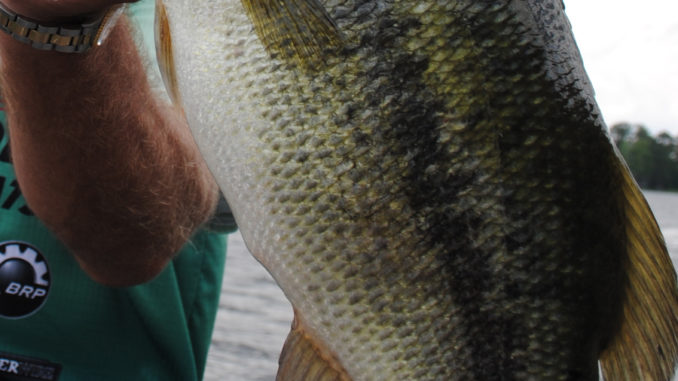
In August, mid-day might be when bass feed
When it’s as hot as it has been this summer, and August has taken over from July, most fishermen think about limiting their trips to the first few hours in the morning and the hours around sundown.
Chances are, they’ll catch a few bass, and maybe a few on topwater baits. But chances are, they’re missing the best fishing of the day. As uncomfortable as it might sound, sometimes, the fishing in the middle of the day might be a lot better, depending on when the fish on your favorite lake feed.
That’s the main thing about fishing in August: finding out when fish are going to feed in different areas. I know on High Rock, my home lake, you can go in Abbotts Creek and catch ’em at 2 in the afternoon, then you can go to Flat Swamp Creek at 3, and they might not be hitting, and they might be biting in Second Creek in the morning.
The big variable is when the power companies that run our lakes start moving water, and in August, that’s often well up in the day, when everybody is running their air conditioners and there’s a big demand for electricity. If you can obtain the schedule for when they’re going to be moving water, that can really help your fishing, and it’s a key factor at almost every lake you’ll ever fish.
Current causes bass to become more active, in part because the moving water moves baitfish around, but also because the water rolling through the dam upstream mixes with the lake’s water and oxygenates it, which gives fish a bump. Bass that are suspended over deep water will move to structure and cover and feed on any baitfish that swim past. They might only feed for 30 minutes or an hour, but for that time, it’s on. Or, they may feed the entire time the water is moving.
What’s really good about August fishing is that when fish get in a pattern of feeding at roughly the same time every day, they might stay in it for weeks at a time. You go to a point or channel bend at 2 o’clock and catch fish on a Monday, then go back Wednesday and Friday at the same time and they’ll bite again.
The only complicating factor in this is that you’ve got to cover a lot of water and figure out when fish are feeding in different parts of a lake, because when current is being generated, it may take a little while for the current to set up in different parts of the lake. If Alcoa is pulling water through High Rock Dam, the current might set up in Flat Swamp and Panther creeks, the two closest to the dam, an hour before it sets up well up the lake in Crane and Swearing creeks.
You need to think about a couple more things. July is the month when bass are usually at their deepest on just about any lake you fish. They actually move up in August, in part because the oxygen in deeper water can get depleted, depending on how much rain we get. I can remember catching fish in 20 or 22 feet of water at Buggs Island in July, then come back and catch ’em in August on a crankbait in 15 feet of water.
A thermocline will often set up in a lake in August when the deeper, cooler water separates from the warmer water toward the surface that has more oxygen. On an old paper graph or on an old flasher unit, you could see the thermocline just by adjusting your sensitivity levels. You’d concentrate on fishing right above the thermocline. What I’ll look for now on my Raymarine electronics would be baitfish. If I see a ton of baitfish around the lake, all of them at the same depth, I know they’re just above the thermocline, and that’s the depth I’ll fish.
I’m not going to look for fish on big, steep breaks, but on contour lines where the depth might drop three or four feet. This time of year, they like hard bottoms with stumps or brush.
If bass are at a depth that I can reach with a crankbait, that’s going to be my first choice, but one of the things that’s really been working over the past year or so has been a stand-up shaky head jig with a big worm. You use a 1/2- or 5/8-ounce head and thread on a big, fat worm or a Senko-type bait. I use an 8- or 10-inch Powerbait worm. With that kind of head, the worm stands straight up or close to it, and that’s really been working. Who knows? Maybe they’ve seen too many Texas rigs and Carolina rigs.
Whatever you do, don’t let the hot weather keep you off the lake. There are too many nice bass to be caught.




Be the first to comment